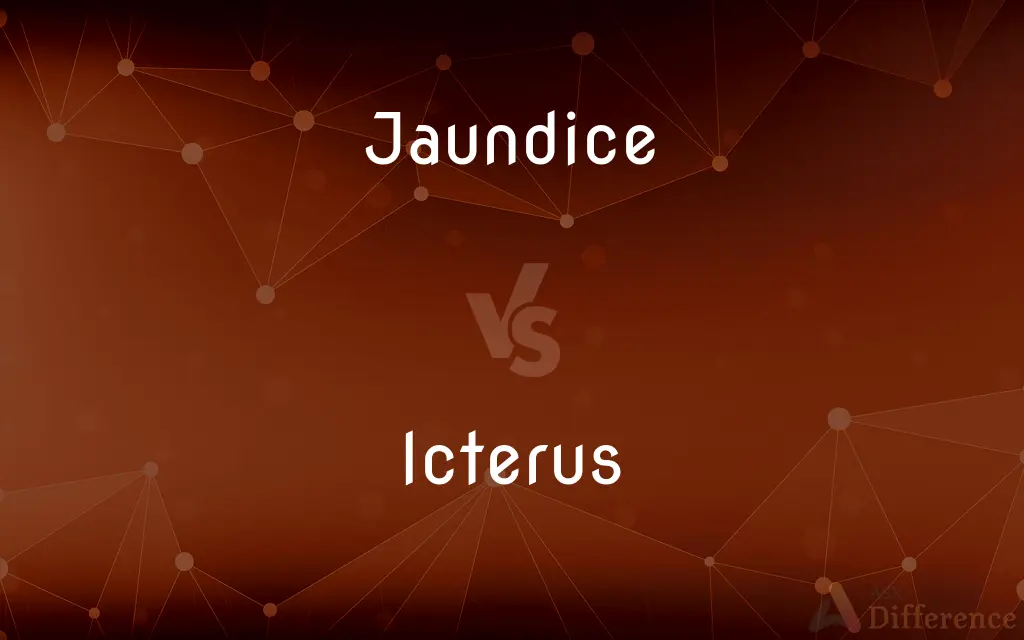Jaundice vs. Icterus — What's the Difference?
By Urooj Arif & Fiza Rafique — Updated on March 21, 2024
Jaundice and icterus both describe yellow discoloration of the skin and eyes, but jaundice also refers to the underlying condition causing this symptom.

Difference Between Jaundice and Icterus
Table of Contents
ADVERTISEMENT
Key Differences
Jaundice is a term that is widely used to describe the yellowing of the skin and the whites of the eyes caused by an excess of bilirubin in the bloodstream. Icterus, on the other hand, is a term more commonly used in medical contexts to specifically denote the yellowish pigmentation of the skin, mucous membranes, and sclera (the white part of the eyes) due to hyperbilirubinemia.
While jaundice is often used to describe the visible symptoms observable in both adults and infants, reflecting an underlying condition such as liver disease, hepatitis, or hemolysis, icterus specifically refers to the symptom itself without implying the cause. This distinction highlights jaundice as a broader concept encompassing both the symptom and its potential underlying conditions.
In clinical settings, jaundice is not only a sign but also a symptom that prompts further investigation to determine its cause. It can indicate a range of health issues, from benign conditions like Gilbert's syndrome to more severe conditions like liver cirrhosis or pancreatic cancer. Icterus, while synonymous with the symptom of jaundice, is more often used in clinical documentation and discussions focusing on the symptomatology rather than the diagnosis or treatment of the underlying condition.
The assessment of jaundice involves evaluating the level of bilirubin in the blood, understanding the patient's history, and conducting physical examinations and tests to identify the cause. Icterus, as a term, is used in the diagnosis process to describe the specific observation of yellow pigmentation, which aids in the differential diagnosis of the patient's condition.
Both jaundice and icterus serve as important indicators of underlying health issues, requiring medical attention to address potential liver dysfunction, bile duct obstruction, or other related conditions. However, the use of the term jaundice often carries broader implications for patient care, encompassing both the identification of the symptom and the management of the underlying cause.
ADVERTISEMENT
Comparison Chart
Definition
Yellow discoloration of skin/eyes due to excess bilirubin, indicating underlying condition
Specific term for yellow pigmentation of skin, mucous membranes, and sclera
Usage
Broader, includes symptom and underlying condition
More specific to the symptom itself
Context
General and medical, refers to both symptom and cause
Primarily medical, focusing on symptom
Implications
Indicates need for diagnostic investigation of cause
Focuses on observation of symptom
Documentation
Used in general and patient discussions
More often used in clinical documentation
Compare with Definitions
Jaundice
Involves elevated bilirubin levels in the bloodstream.
His jaundice was due to an increased level of bilirubin.
Icterus
Observed in the sclera, mucous membranes, and skin.
The first sign of icterus is often yellowing of the sclera.
Jaundice
Can occur in both adults and newborns.
Neonatal jaundice is common and usually harmless.
Icterus
The medical term for the yellow discoloration of the skin and eyes.
Icterus was evident in his eyes, indicating liver dysfunction.
Jaundice
Can indicate liver disease, bile duct obstruction, or other health issues.
Persistent jaundice may suggest a serious underlying liver condition.
Icterus
Important for diagnosis in clinical settings.
Noting icterus was crucial in diagnosing his condition.
Jaundice
A condition characterized by yellowing of the skin and eyes.
The newborn was diagnosed with jaundice.
Icterus
Specifically refers to the symptom rather than the cause.
The patient's icterus led to further tests for liver function.
Jaundice
Requires medical evaluation to determine the underlying cause.
Her doctor ordered tests to find the cause of her jaundice.
Icterus
Can be a sign of various health conditions.
Icterus can result from hemolysis or hepatic obstruction.
Jaundice
Jaundice, also known as icterus, is a yellowish or greenish pigmentation of the skin and whites of the eyes due to high bilirubin levels. Jaundice in adults is typically a sign indicating the presence of underlying diseases involving abnormal heme metabolism, liver dysfunction, or biliary-tract obstruction.
Icterus
See jaundice.
Jaundice
Yellowish discoloration of the whites of the eyes, skin, and mucous membranes caused by deposition of bile salts in these tissues. It occurs as a symptom of various diseases, such as hepatitis, that affect the processing of bile. Also called icterus.
Icterus
(medicine) An excess of bile pigments in the blood; jaundice.
Jaundice
A state or feeling of negativity or bitterness arising especially from envy or world-weariness.
Icterus
A yellowish appearance in plants.
Jaundice
To affect with the discoloration of jaundice.
Icterus
The jaundice.
Jaundice
To affect with the negativity or bitterness of jaundice.
Icterus
Yellowing of the skin and the whites of the eyes caused by an accumulation of bile pigment (bilirubin) in the blood; can be a symptom of gallstones or liver infection or anemia
Jaundice
(pathology) A morbid condition, characterized by yellowness of the eyes, skin, and urine.
Icterus
Type genus of the Icteridae
Jaundice
(figurative) A feeling of bitterness, resentment or jealousy.
Jaundice
(transitive) To affect with jaundice; to color by prejudice or envy; to prejudice.
Jaundice
A morbid condition, characterized by yellowness of the eyes, skin, and urine, whiteness of the fæces, constipation, uneasiness in the region of the stomach, loss of appetite, and general languor and lassitude. It is caused usually by obstruction of the biliary passages and consequent damming up, in the liver, of the bile, which is then absorbed into the blood.
Jaundice
To affect with jaundice; to color by prejudice or envy; to prejudice.
The envy of wealth jaundiced his soul.
Jaundice
Yellowing of the skin and the whites of the eyes caused by an accumulation of bile pigment (bilirubin) in the blood; can be a symptom of gallstones or liver infection or anemia
Jaundice
A sharp and bitter manner
Jaundice
Distort adversely;
Jealousy had jaundiced his judgment
Jaundice
Affect with, or as if with, jaundice
Common Curiosities
What is jaundice?
Jaundice is a condition characterized by the yellow discoloration of the skin and eyes, indicating an excess of bilirubin in the bloodstream.
What causes jaundice?
Causes of jaundice include liver dysfunction, hemolysis (destruction of red blood cells), and obstruction of the bile duct, leading to bilirubin buildup.
What treatments are available for jaundice and icterus?
Treatment targets the underlying cause; it may involve medication, surgery, or other interventions to reduce bilirubin levels and address the primary condition.
How are jaundice and icterus diagnosed?
Diagnosis involves blood tests to measure bilirubin levels, physical examinations, and potentially imaging studies to identify the cause of the bilirubin buildup.
Are newborns commonly affected by jaundice?
Yes, neonatal jaundice is common due to the immature liver of the newborn, usually resolving without serious complications.
How is newborn jaundice treated?
Treatment for neonatal jaundice may include phototherapy or, in more severe cases, blood transfusions to reduce bilirubin levels.
How is icterus different from jaundice?
Icterus specifically refers to the yellowish pigmentation of the skin and eyes due to high bilirubin levels, while jaundice also considers the underlying health issues causing this symptom.
Is icterus a serious condition?
Icterus itself is a symptom that can indicate serious underlying conditions; its seriousness depends on the root cause of the elevated bilirubin levels.
Why is jaundice significant in medical diagnosis?
Jaundice signifies potential health problems, such as liver disease or bile duct obstruction, necessitating further investigation to determine the cause.
Can icterus occur without jaundice?
Icterus is essentially the same symptom as observed in jaundice; the terms are often used interchangeably, though icterus is more specific to the symptom itself.
Can diet affect jaundice or icterus?
While diet alone doesn't directly cause or cure jaundice or icterus, proper nutrition supports liver health and can aid in managing underlying conditions.
Can jaundice occur in healthy individuals?
Certain conditions, like Gilbert's syndrome, can cause jaundice in otherwise healthy individuals due to mild increases in bilirubin levels.
Does jaundice always indicate liver disease?
While liver disease is a common cause, jaundice can also result from other factors, such as hemolysis or genetic conditions.
What role does bilirubin play in jaundice and icterus?
Bilirubin, a byproduct of red blood cell breakdown, causes the yellow pigmentation of the skin and eyes when its levels become elevated in the bloodstream.
Is jaundice contagious?
No, jaundice itself is not contagious, but some underlying causes, such as viral hepatitis, can be transmitted from person to person.
Share Your Discovery

Previous Comparison
Beethoven vs. Bach
Next Comparison
Ethics vs. EthicAuthor Spotlight
Written by
Urooj ArifUrooj is a skilled content writer at Ask Difference, known for her exceptional ability to simplify complex topics into engaging and informative content. With a passion for research and a flair for clear, concise writing, she consistently delivers articles that resonate with our diverse audience.
Co-written by
Fiza RafiqueFiza Rafique is a skilled content writer at AskDifference.com, where she meticulously refines and enhances written pieces. Drawing from her vast editorial expertise, Fiza ensures clarity, accuracy, and precision in every article. Passionate about language, she continually seeks to elevate the quality of content for readers worldwide.
















































